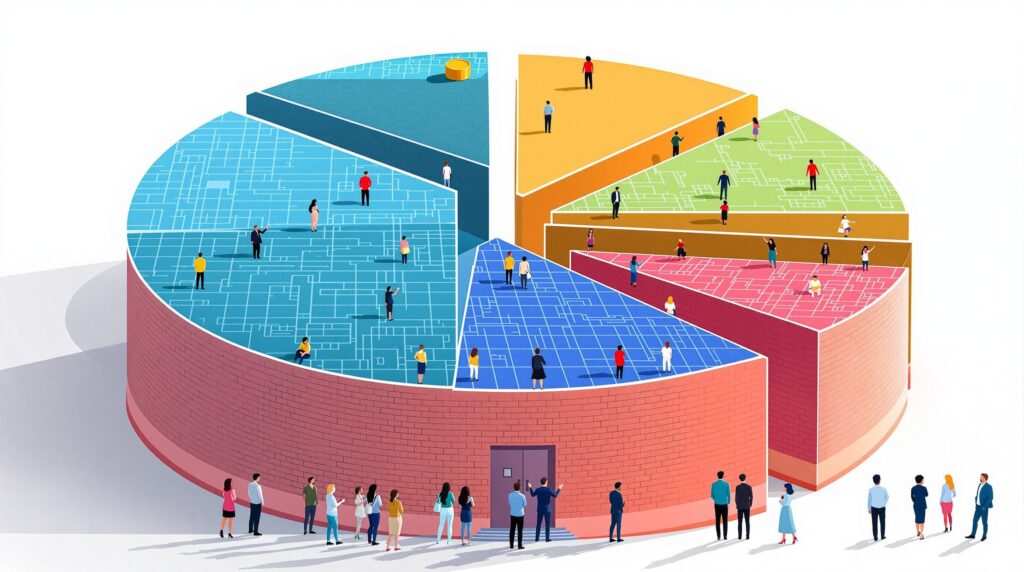[rev_slider alias=”slider-1″][/rev_slider]
Introduction to Layer 1 and Layer 2 Blockchain Solutions
Blockchain technology has revolutionized the way industries operate by introducing decentralized, secure, and transparent solutions. However, scalability and transaction speed remain ongoing challenges. Here, we delve into Layer 1 and Layer 2 blockchain solutions that offer pathways to solving these issues, ensuring the blockchain ecosystem functions efficiently.
Understanding Layer 1 Solutions
Layer 1 solutions are the foundational components of blockchain networks, serving as the base layer. This includes the protocol itself, such as Bitcoin or Ethereum. Layer 1 is responsible for consensus mechanisms, transaction finality, and network security. These blockchains can face scalability challenges as they process all transactions on-chain.
- Consensus Mechanisms: Methodologies like Proof of Work (PoW) or Proof of Stake (PoS) are utilized to validate and secure transactions.
- Security: Layer 1 networks offer robust security by ensuring all transactions are validated through decentralized nodes.
- Limitations: Due to on-chain processing, transaction speeds can be slower, and network congestion can increase costs.
Unpacking Layer 2 Solutions
Layer 2 solutions build on top of existing Layer 1 protocols to enhance scalability and efficiency. These include off-chain solutions like Lightning Network for Bitcoin or Plasma for Ethereum. Layer 2 significantly reduces the load on the base layer by processing transactions off-chain, before settling them on-chain.
- Off-Chain Transactions: These allow for multiple transactions to be condensed into one single record on the blockchain, reducing congestion.
- Increased Scalability: By handling high volumes of transactions off-chain, Layer 2 solutions increase the network’s capacity.
- Lower Costs: Reducing on-chain transactions cuts down transaction fees, making it cost-effective.
Why are Layer 1 and Layer 2 solutions important? Layer 1 serves as the foundation of blockchain networks, while Layer 2 scales operations by offloading transaction processing, leading to faster and more affordable blockchain usage.
The Role of Blockchain Solutions in Africa
In Africa, the successful implementation of Layer 1 and Layer 2 blockchain solutions could bridge economic divides by enabling enhanced fintech services and financial inclusion. As a continent with significant untapped potential, optimizing blockchain technology could herald a new era of prosperity.
“Your Voice, Our Mission” – We aim to facilitate Africa’s growth by leveraging cutting-edge blockchain technologies to empower economies.
For businesses in Africa, adopting these advanced blockchain solutions could mean improved equity access, faster financial transactions, and greater participation in the global economy. With Jara’s downloadable app, users are equipped with tools to navigate and participate in the digital asset revolution.
As investors and entrepreneurs seek opportunities in Africa’s burgeoning digital economy, exploring the dynamics of blockchain and cryptocurrency provides a strategic advantage.
Furthermore, as the technology evolves, blockchain development in Africa continues to offer exciting new frontiers for innovation and investment in the digital economy, with strategic partnerships playing a vital role.
The adoption of scalable blockchain solutions enables African markets to overcome infrastructure challenges, driving innovation and economic growth.
Top Emerging Layer 1 Blockchains
Blockchain #1: Solana and Its Unique Value Proposition
Let’s take a deep dive into Solana, one of the prominent layer 1 blockchains emerging on the scene. Solana has drawn significant attention due to its blazing-fast transaction speeds and scalable architecture. But what exactly makes Solana stand out, and why should we be keeping a close eye on this blockchain?
What is Solana? Solana is a high-performance blockchain supporting fast, secure, and scalable decentralized applications and crypto-currencies with a transaction speed of 65,000 transactions per second.
Key Features of Solana
- High Throughput: Solana can process 65,000 transactions per second, thanks to its innovative architecture, making it one of the fastest blockchains available today.
- Low Transaction Costs: With low fees, Solana is an attractive option for developers aiming to build cost-effective decentralized applications.
- Scalability: Solana is designed to remain scalable as its ecosystem grows, addressing one of the major hurdles faced by many other blockchains.
Solana’s Consensus Mechanism
Unlike traditional blockchains that rely on proof-of-work, Solana utilizes a unique consensus mechanism called Proof of History (PoH), which introduces a timestamped record of transactions to improve efficiency and security. This mechanism complements the layer 2 solutions found in more recent blockchain developments.
Proof of History: A novel consensus mechanism allowing nodes to agree on time, crucial for enabling instant blocks and reducing transaction processing delays.
Solana’s Ecosystem and Partnerships
Solana’s vibrant ecosystem is rapidly expanding, with partnerships enhancing its utility and adoption. Significant collaborations with projects like Serum, a decentralized exchange built on Solana, highlight its growing influence in the DeFi space. As part of the African blockchain revolution, Solana’s infrastructure offers substantial opportunities for increased financial inclusion across the continent.
- Serum: A next-generation decentralized exchange benefiting from Solana’s speed and low transaction costs.
- Metaplex: A tool that empowers digital creators to launch their NFT storefronts on Solana with ease.
- Partnerships: Extensive collaborations within the crypto-space to advocate for mainstream adoption and build upon Solana’s capabilities.
The Potential of Solana in Africa
As the digital landscape in Africa continues to evolve, Solana’s robust network provides a strategic advantage in addressing the continent’s unmet financial needs. Its focus on scalability and low-cost execution opens up potential for transformative applications across African markets.
Given the above advantages, $JARA’s ecosystem could leverage Solana’s network to tokenize large-scale projects, such as the Lagos airport initiative, tapping into global capital and fostering economic growth.
“Your Voice, Our Mission” – we champion your rights with the tenacity and dedication that has earned us the trust of our community members.
As Jara aims to fuel Africa’s thriving digital asset economy, Solana presents a compelling ally in providing scalable solutions for asset tokenization and cross-border transactions. Investing in technological advancements like Solana can truly catalyze financial inclusion and economic empowerment in African nations.
[rev_slider alias=”text-call-cta”][/rev_slider]
Comparative Analysis of Emerging Layer 1 Blockchains
With blockchain technology rapidly evolving, understanding the strengths and weaknesses of emerging Layer 1 blockchains is key to anticipating their impact on the market, particularly in Africa’s burgeoning digital landscape. Let’s delve into an analysis of the leading layer 1 blockchains to watch, evaluating their potential and growth opportunities.
1. Solana: Speed Meets Scalability
Solana has gained attention for its high throughput and low transaction costs, making it a standout choice for decentralized applications. Its unique consensus mechanism known as Proof of History (PoH) is pivotal in achieving high speeds without sacrificing decentralization. This makes Solana appealing for Africa, where transaction speed and cost-efficiency are crucial.
- Strengths: High scalability, low fees, strong developer community.
- Weaknesses: Occasional network instability, relatively young ecosystem.
Solana’s technology empowers efficient transactions crucial for regions with large unbanked populations, making it a catalyst for financial inclusion in Africa.
2. Polkadot: Interconnecting Blockchains
Polkadot stands out for its interoperability and ability to connect multiple blockchains into a single network, termed a “parachain.” This capability can significantly impact Africa where seamless integration with existing systems is vital.
- Strengths: High interoperability, robust governance model.
- Weaknesses: Complexity in execution, lengthy development phases for parachains.
3. Avalanche: Custom Blockchain Creation
Avalanche provides a platform for creating custom blockchain networks while maintaining the speed and security of a public ledger. This adaptability makes it a potential game-changer for African entrepreneurs and developers looking to create tailored solutions.
- Strengths: High adaptability, low latency transactions.
- Weaknesses: Competitive DeFi landscape, ongoing optimization needed.
“Think of Avalanche as a technological playground for developers wanting to build custom solutions, thereby fostering innovative financial solutions in Africa.”
4. Algorand: Pure Proof of Stake Innovation
Algorand utilizes a pure Proof of Stake (PPoS) consensus algorithm to offer fast and secure transactions, appealing greatly to environments that demand reliable financial infrastructure like Africa. Its focus on sustainability and minimal environmental impact is an added advantage.
- Strengths: Environmentally friendly, high transaction throughput.
- Weaknesses: Lesser-known amongst developers, smaller ecosystem.
5. Cardano: Research-Driven Blockchain
Cardano brings a research-focused approach to blockchain development, ensuring robust security and sustainability. Its emphasis on peer-reviewed research and academic rigor can be crucial for building trust in digital currencies across Africa.
- Strengths: Strong focus on research and development, scalability potential.
- Weaknesses: Slower development compared to competitors, delayed smart contract capabilities initially.
Cardano’s commitment to peer-reviewed research positions it as a trustworthy option for integrating blockchain solutions within African economies.
As we continue to explore the potential of these emerging Layer 1 blockchains, their growth trajectory will surely influence Africa’s digital transformation journey. By understanding their distinctive qualities and assessing how they align with regional needs, stakeholders can unlock new pathways to innovation and economic empowerment.
Future Outlook for Layer 1 Blockchains
As we look towards the future, the potential growth and evolution of Layer 1 blockchains appear immensely promising. These foundational blockchains, responsible for the basic layer of transaction processing and record-keeping, are poised to undergo significant advancements as they strive to address scalability issues, enhance security, and increase transaction throughput. But what exactly could these changes entail?
What’s next for Layer 1 blockchains? Innovations in scalability and security will play a critical role in the widespread adoption of blockchain technology.
Currently, most Layer 1 blockchains are grappling with the challenge of scalability. Traditional blockchain networks like Bitcoin and Ethereum have limitations in how many transactions they can process at a time. To solve this, many developers are exploring the implementation of sharding, a method that partitions the network into smaller parts, thus enabling parallel transaction processing. Another promising solution is the adoption of proof-of-stake (PoS) mechanisms, which not only enhance scalability but also reduce energy consumption drastically – a significant environmental consideration.
In Africa, where technological innovations and mobile connectivity are rapidly advancing, the potential for Layer 1 blockchains is particularly compelling. By integrating effective blockchain solutions with existing financial systems, platforms like Jara are catalyzing economic empowerment and inclusion. Jara’s market-oriented approach helps in removing barriers to entry and promotes accessibility to the broader digital economy.
Beyond scalability, enhancing security measures within Layer 1 blockchains is pivotal. As cyber threats grow in sophistication, blockchain security must evolve accordingly. By integrating zero-knowledge proofs and homomorphic encryption, Layer 1 blockchains can ensure privacy while maintaining transparency, a balance critical to user trust and regulatory compliance.
The synergy between Layer 1 and Layer 2 solutions is also vital for the foreseeable future. While Layer 1 serves as the core protocol layer, Layer 2 solutions provide off-chain processing to alleviate blockchain congestion. This collaboration leads to more robust networks that offer users fast, secure, and low-cost transaction experiences. As Africa accelerates its digital transformation, platforms like Jara leverage these technologies to foster digital asset ecosystems that disrupt traditional financial structures and pave the way for innovative economic models.
“Invest in technologies that solve real-world issues” – Layer 1 blockchains are set to revolutionize how we perceive and utilize digital assets globally.
In conclusion, the ongoing advancements in Layer 1 blockchains signal a dynamic shift towards more efficient, secure, and accessible blockchain ecosystems. With Africa becoming a bustling hub for digital innovation, these developments could transform how people across the continent engage with financial systems. For entities like Jara, embracing these emerging technologies means paving the path for financial inclusivity and investment opportunities on a global scale.
[rev_slider alias=”schedule-consultation-btn”][/rev_slider]

What is a Layer 1 Blockchain?
Layer 1 blockchain refers to the base level of blockchain technology upon which other protocols are built. It includes the core framework such as the consensus algorithm that governs how transactions are verified and added to the blockchain.
A Layer 1 blockchain is the foundational network such as Bitcoin or Ethereum, handling transactions directly on its network without relying on additional protocols.
Why are Layer 1 blockchains significant?
Layer 1 blockchains are significant because they constitute the primary network on which all other blockchain activities and applications are built. They manage core operations such as transactions and security, influencing the efficiency and scalability of the entire ecosystem.
Layer 1 blockchains like Ethereum and Bitcoin are critical as they provide the base infrastructure for decentralized applications and smart contracts to operate.
How does a Layer 1 differ from a Layer 2 blockchain?
A Layer 1 blockchain is the primary chain handling the core functionalities of a blockchain network, such as consensus and data sharing. In contrast, a Layer 2 blockchain operates on top of a Layer 1 with the aim of enhancing performance, scalability, and efficiency by managing operations off-chain.
- Layer 1: Handles fundamental operations and carries the transaction processing burden.
- Layer 2: Focuses on scaling solutions like side chains or state channels to improve speed and reduce congestion on the main chain.
What factors determine the growth of emerging Layer 1 blockchains?
A variety of factors determine the growth of emerging Layer 1 blockchains, including technological innovation, adoption rates, scalability solutions, and community support. Additionally, strategic partnerships and regulatory compliance play crucial roles in their long-term success.
The growth of new Layer 1 blockchains is driven by innovation, user adoption, and strategic industry alliances.

Related Pages on Emerging Blockchain Technologies
Explore a curated list of related topics that provide deeper insights into blockchain technologies and their applications in various sectors.
Discover What Our Blockchain Clients Are Saying
At the forefront of our Layer 1 and Layer 2 blockchain solutions practice is a deep-seated commitment to client satisfaction. Each case is handled with utmost care, as echoed in the appreciative feedback from those we represent.

[rev_slider alias=”slider-3″][/rev_slider]
[rev_slider alias=”slider-6″][/rev_slider]
Why Choose Jara for Your Blockchain Solutions?
At Jara, we are passionate about empowering our clients with cutting-edge blockchain solutions. Whether you’re diving into Layer 1 or Layer 2 blockchain technologies, our team possesses the experience and knowledge to guide you through every step. When you choose us, you choose innovation, reliability, and a partner committed to your success.
“Your Voice, Our Mission” – we champion your rights with the tenacity and dedication that has earned us the trust of our community members.
Our Achievements in Blockchain Excellence
- Highlighted among the “Top Blockchain Consultants” for 2023 by Blockchain Review. This recognition honors our commitment to delivering pioneering blockchain consulting services. See the list
- Listed as one of the “Best Emerging Tech Firms” by Tech Innovate 2023. Acknowledgment for our strides in integrating technology with practical applications. Learn more
- Named among the “Leading Fintech Innovators” for 2023 by Fintech Industry Awards. This highlights our role in adapting financial technologies to new frontiers. Explore more
- Recognized in the “Top Blockchain Pioneers” by The Future of Tech 2023. A testament to our forward-thinking approach and creative solutions. View the full list
- Listed as one of the “Most Innovative Crypto Solutions” by Crypto Tech Awards 2023. Celebrating our radical innovations in the cryptocurrency domain. Discover more
Chinyere “Chi” Nnadi Bio
Founder and CEO, Jara | Blockchain Technology Specialist
Content reviewed by Chi Nnadi and his content team. Chi is an experienced entrepreneur committed to transforming Africa’s financial ecosystem via blockchain technology. As Founder and CEO of Jara, he creates enterprise-grade infrastructure that converts illiquid African assets into globally accessible digital tokens. Using his proprietary Layer-2 blockchain technology, Chi connects global investors with Africa’s emerging digital asset market.
Our Content Review Process
Chi Nnadi along with Jara’s dedicated content team, pledge to offer top-notch material. Our content guidelines ensure thoroughness, reputable sources, unbiased scrutiny, among other quality metrics. Please let us know if there is anything you believe to be inaccurate.
















